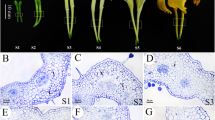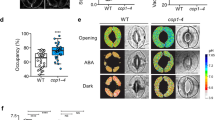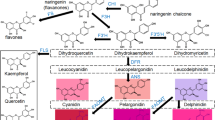Abstract
The regulation of pH in cellular compartments is crucial for intracellular trafficking of vesicles and proteins and the transport of small molecules, including hormones. In endomembrane compartments, pH is regulated by vacuolar H+-ATPase1 (V-ATPase), which, in plants, act together with H+-pyrophosphatases2 (PPase), whereas distinct P-type H+-ATPases in the cell membrane control the pH in the cytoplasm and energize the plasma membrane3. Flower colour mutants have proved useful in identifying genes controlling the pH of vacuoles where anthocyanin pigments accumulate4,5. Here we show that PH5 of petunia encodes a P3A-ATPase proton pump that, unlike other P-type H+-ATPases, resides in the vacuolar membrane. Mutation of PH5 reduces vacuolar acidification in petals, resulting in a blue flower colour and abolishes the accumulation of proanthocyanindins (condensed tannins) in seeds. Expression of PH5 is directly activated by transcription regulators of the anthocyanin pathway, in conjunction with PH3 and PH4. Thus, flower coloration, a key-factor in plant reproduction, involves the coordinated activation of pigment synthesis and a specific pathway for vacuolar acidification.
This is a preview of subscription content, access via your institution
Access options
Subscribe to this journal
Receive 12 print issues and online access
$209.00 per year
only $17.42 per issue
Buy this article
- Purchase on Springer Link
- Instant access to full article PDF
Prices may be subject to local taxes which are calculated during checkout





Similar content being viewed by others
References
Nishi, T. & Forgac, M. The vacuolar (H+)-ATPases — nature's most versatile proton pumps. Nature Rev. Mol. Cell Biol. 3, 94–103 (2002).
Gaxiola, R. A., Fink, G. R. & Hirschi, K. D. Genetic manipulation of vacuolar proton pumps and transporters. Plant Physiol. 129, 967–973 (2002).
Palmgren, M. G. Plant plasma membrane H+-ATPases: powerhouses for nutrient uptake. Annu. Rev. Plant Physiol. Plant Mol. Biol. 52, 817–845 (2001).
Fukada-Tanaka, S., Inagaki, Y., Yamaguchi, T., Saito, N. & Iida, S. Colour-enhancing protein in blue petals. Nature 407, 581 (2000).
Quattrocchio, F. et al. PH4 of petunia is an R2R3-MYB protein that activates vacuolar acidification through interactions with Basic-Helix-Loop-Helix transcription factors of the anthocyanin pathway. Plant Cell 18, 1274–1291 (2006).
Mol, J., Grotewold, E. & Koes, R. How genes paint flowers and seeds. Trends Plant Sci. 3, 212–217 (1998).
Yoshida, K., Toyama-Kato, Y., Kameda, K. & Kondo, T. Sepal color variation of Hydrangea macrophylla and vacuolar pH measured with a proton-selective microelectrode. Plant Cell Physiol. 44, 262–268 (2003).
Koes, R., Verweij, C. W. & Quattrocchio, F. Flavonoids: a colorful model for the regulation and evolution of biochemical pathways. Trends Plant Sci. 5, 236–242 (2005).
Spelt, C., Quattrocchio, F., Mol, J. & Koes, R. ANTHOCYANIN1 of petunia controls pigment synthesis, vacuolar pH, and seed coat development by genetically distinct mechanisms. Plant Cell 14, 2121–2135. (2002).
Jorgensen, R. A., Cluster, P. D., English, J., Que, Q. & Napoli, C. A. Chalcone synthase cosuppression phenotypes in petunia flowers: comparison of sense vs. antisense constructs and single-copy versus complex T-DNA sequences. Plant Mol. Biol. 31, 957–973 (1996).
Baxter, I. et al. Genomic comparison of P-type ATPase ion pumps in Arabidopsis and rice. Plant Physiol. 132, 618–628 (2003).
Baxter, I. R. et al. A plasma membrane H+-ATPase is required for the formation of proanthocyanidins in the seed coat endothelium of Arabidopsis thaliana. Proc. Natl Acad. Sci. USA 102, 2649–2654 (2005).
de Kerchove d'Exaerde, A. et al. Functional complementation of a null mutation of the yeast Saccharomyces cerevisiae plasma membrane H+-ATPase by a plant H+-ATPase gene. J. Biol. Chem. 270, 23828–23837 (1995).
Marinova, K. et al. The Arabidopsis MATE transporter TT12 acts as a vacuolar flavonoid/H+-antiporter active in proanthocyanidin-accumulating cells of the seed coat. Plant Cell 19, 2023–2038 (2007).
Spelt, C., Quattrocchio, F., Mol, J. & Koes, R. anthocyanin1 of petunia encodes a basic-Helix Loop Helix protein that directly activates structural anthocyanin genes. Plant Cell 12, 1619–1631 (2000).
Lefebvre, B. et al. Identification of a Nicotiana plumbaginifolia plasma membrane H+-ATPase gene expressed in the pollen tube. Plant Mol. Biol. 58, 775–787 (2005).
DeWitt, N. D., Hong, B., Sussman, M. R. & Harper, J. F. Targeting of two Arabidopsis H+-ATPase isoforms to the plasma membrane. Plant Physiol. 112, 833–844 (1996).
Kim, D. H. et al. Trafficking of phosphatidylinositol 3-phosphate from the trans-Golgi network to the lumen of the central vacuole in plant cells. Plant Cell 13, 287–301 (2001).
Fluckiger, R. et al. Vacuolar system distribution in Arabidopsis tissues, visualized using GFP fusion proteins. J Exp Bot 54, 1577–1584 (2003).
Czempinski, K., Frachisse, J. M., Maurel, C., Barbier-Brygoo, H. & Mueller-Roeber, B. Vacuolar membrane localization of the Arabidopsis 'two-pore' K+ channel KCO1. Plant J. 29, 809–820 (2002).
Shaner, N. C. et al. Improved monomeric red, orange and yellow fluorescent proteins derived from Discosoma sp. red fluorescent protein. Nature Biotechnol. 22, 1567–1572 (2004).
Fuchs, R., Schmid, S. & Mellman, I. A possible role for Na+/K+-ATPase in regulating ATP-dependent endosome acidification. Proc. Natl Acad. Sci. USA 86, 539–543 (1989).
Schumacher, K. et al. The Arabidopsis det3 mutant reveals a central role for the vacuolar H+-ATPase in plant growth and development. Genes Dev. 13, 3259–3270 (1999).
Li, J. et al. Arabidopsis H+-PPase AVP1 regulates auxin-mediated organ development. Science 310, 121–125 (2005).
Goodman, C. D., Casati, P. & Walbot, V. A multidrug resistance-associated protein involved in anthocyanin transport in Zea mays. Plant Cell 16, 1812–1826 (2004).
Koes, R. E., Quattrocchio, F. & Mol, J. N. M. The flavonoid biosynthetic pathway in plants: function and evolution. BioEssays 16, 123–132 (1994).
Ando, T. et al. A morphological study of the Petunia integrifolia complex (Solanaceae). Ann. Bot. 96, 887–900 (2005).
Tobeña-Santamaria, R. et al. FLOOZY of petunia is a flavin monooxygenase-like protein required for the specification of leaf and flower architecture. Genes Dev. 6, 753–763 (2002).
Karimi, M., Inze, D. & Depicker, A. GATEWAY vectors for Agrobacterium-mediated plant transformation. Trends Plant Sci. 7, 193–195 (2002).
Vermeer, J. E., Van Munster, E. B., Vischer, N. O. & Gadella, T. W., Jr. Probing plasma membrane microdomains in cowpea protoplasts using lipidated GFP-fusion proteins and multimode FRET microscopy. J. Microsc. 214, 190–200 (2004).
Acknowledgements
We are grateful to. Inhwan Hwang (Pohang, Korea) and Katrin Czempinski (Golm, Germany) for AHA2–GFP and KCO1–GFP constructs, and to Dorus Gadella (University of Amsterdam, The Netherlands) for the use of confocal microscopy facilities. We thank Pieter Hoogeveen, Martina Meesters and Daisy Kloos for plant care. This work was supported by a grant from The Netherlands Organization of Scientific Research (NWO-ALW).
Author information
Authors and Affiliations
Contributions
W.V. and C.S. contributed equally to the experimental work; G.P.S. and J.V. contributed to the GFP localization studies; L.R and F.F. ; performed the immunogold experiments and electron microscopy; F.Q. and R.K. ; conceived the project, performed the genetic analysis and wrote the manuscript.
Corresponding author
Ethics declarations
Competing interests
The authors declare no competing financial interests.
Supplementary information
Supplementary Information
Supplementary Information (PDF 880 kb)
Rights and permissions
About this article
Cite this article
Verweij, W., Spelt, C., Di Sansebastiano, GP. et al. An H+ P-ATPase on the tonoplast determines vacuolar pH and flower colour. Nat Cell Biol 10, 1456–1462 (2008). https://doi.org/10.1038/ncb1805
Received:
Accepted:
Published:
Issue Date:
DOI: https://doi.org/10.1038/ncb1805
This article is cited by
-
Transcriptional profiling of long noncoding RNAs associated with flower color formation in Ipomoea nil
Planta (2023)
-
Flavonoids: a review on biosynthesis and transportation mechanism in plants
Functional & Integrative Genomics (2023)
-
Regulation of a vacuolar proton-pumping P-ATPase MdPH5 by MdMYB73 and its role in malate accumulation and vacuolar acidification
aBIOTECH (2023)
-
Response of tropical trees to elevated Ozone: a Free Air Ozone Enrichment study
Environmental Monitoring and Assessment (2023)
-
Mechanisms and regulation of organic acid accumulation in plant vacuoles
Horticulture Research (2021)



